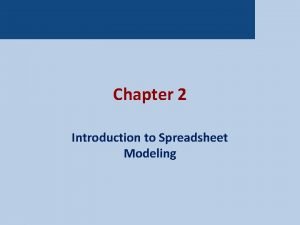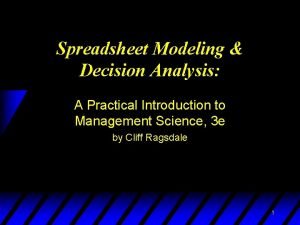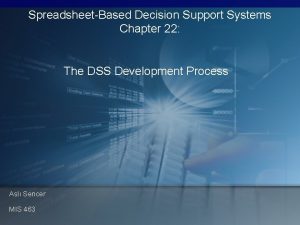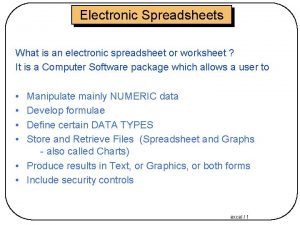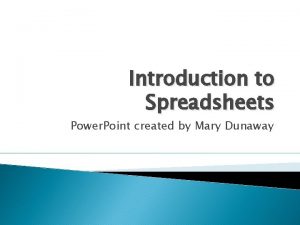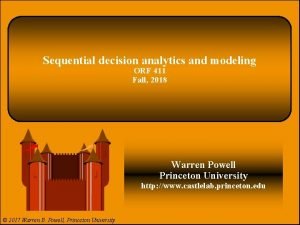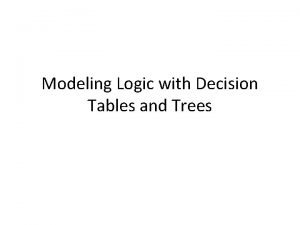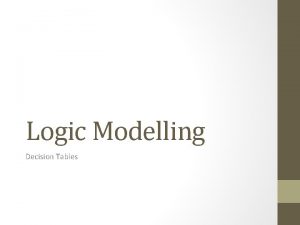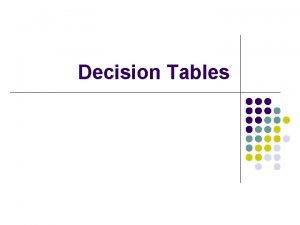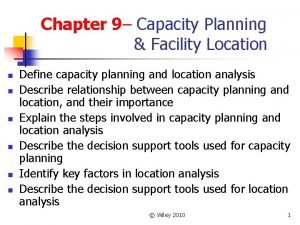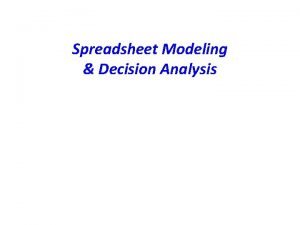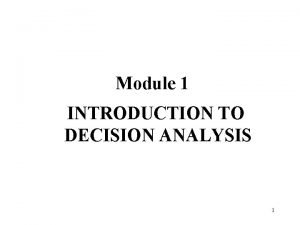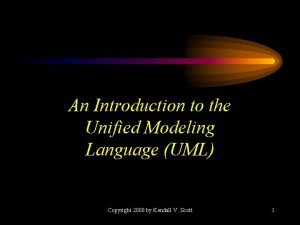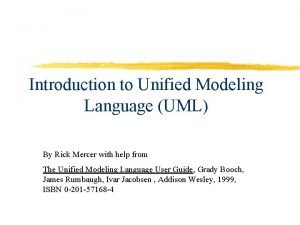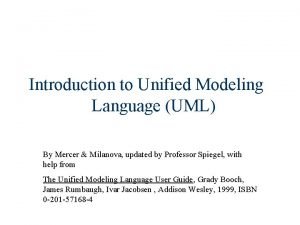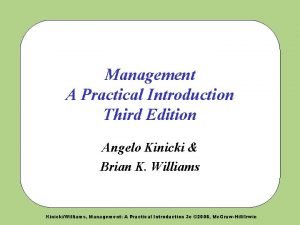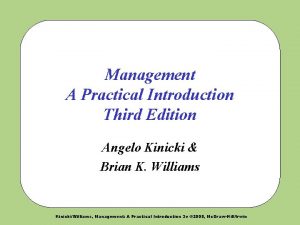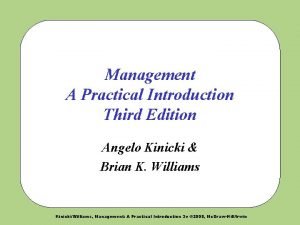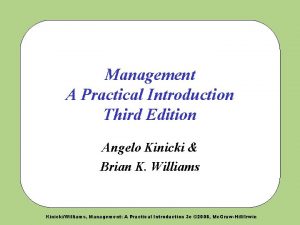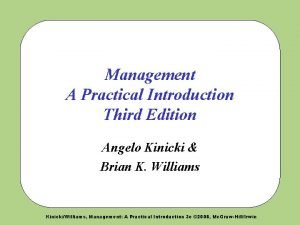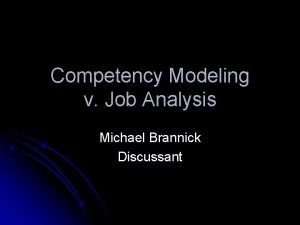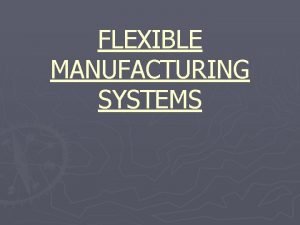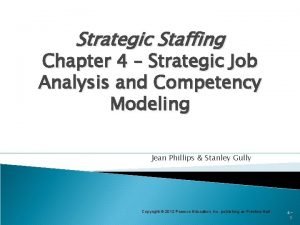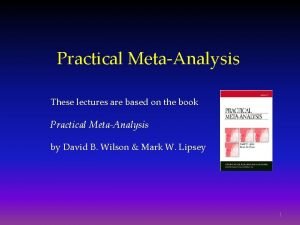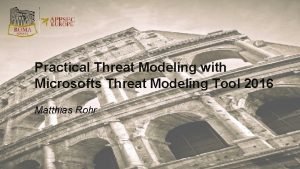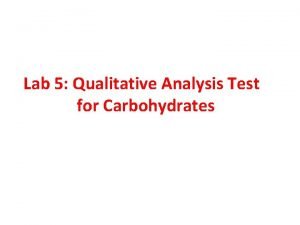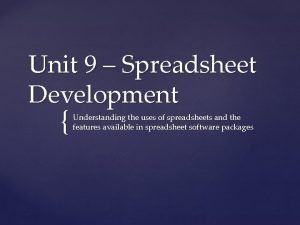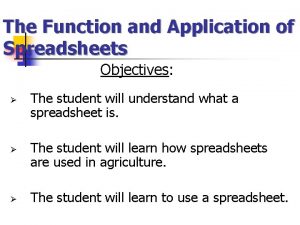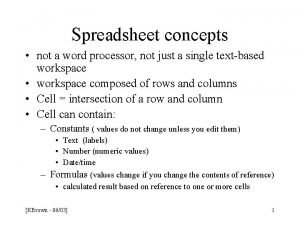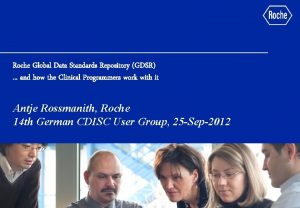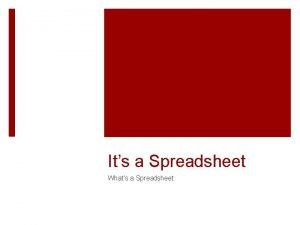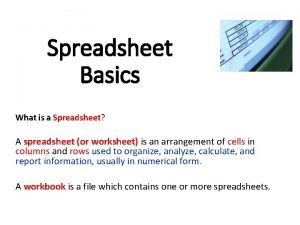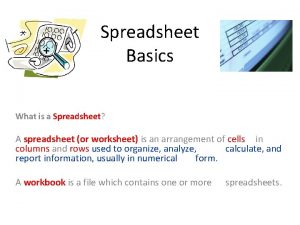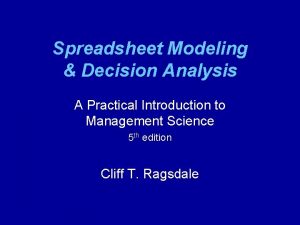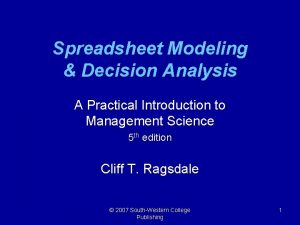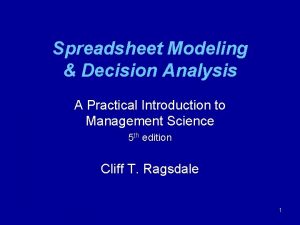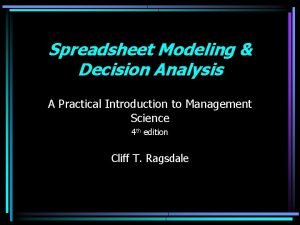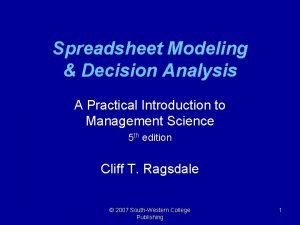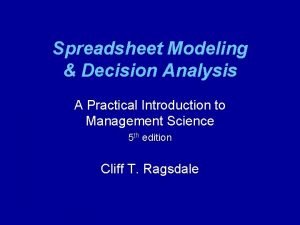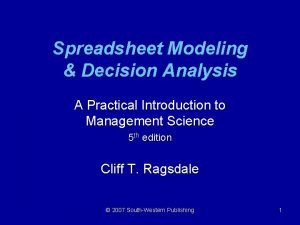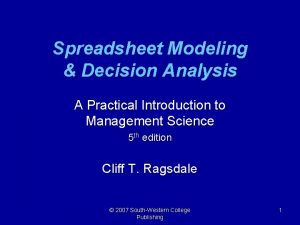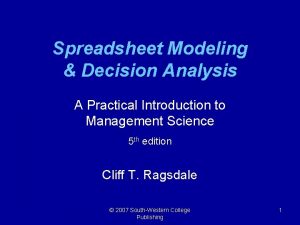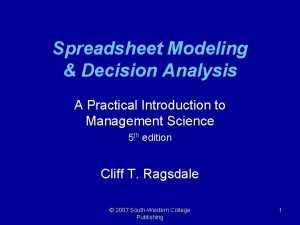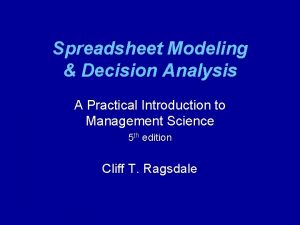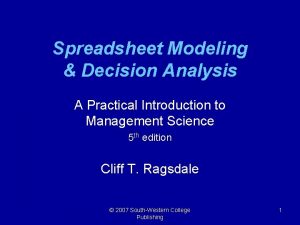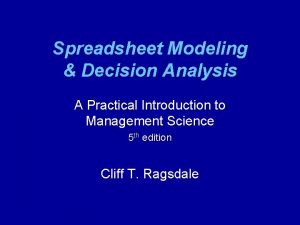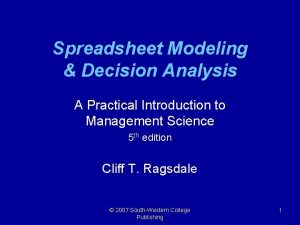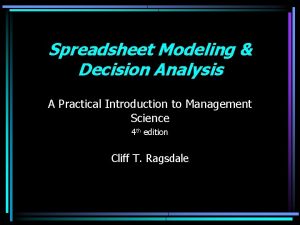Spreadsheet Modeling Decision Analysis A Practical Introduction to










































- Slides: 42

Spreadsheet Modeling & Decision Analysis A Practical Introduction to Management Science 5 th edition Cliff T. Ragsdale

Chapter 12 Introduction to Simulation Using @RISK

On Uncertainty and Decision-Making… "Uncertainty is the most difficult thing about decision-making. In the face of uncertainty, some people react with paralysis, or they do exhaustive research to avoid making a decision. The best decision-making happens when the mental environment is focused. …That fined-tuned focus doesn’t leave room for fears and doubts to enter. Doubts knock at the door of our consciousness, but you don't have to have them in for tea and crumpets. " -- Timothy Gallwey, author of The Inner Game of Tennis and The Inner Game of Work.

Introduction to Simulation § In many spreadsheets, the value for one or more cells representing independent variables is unknown or uncertain. § As a result, there is uncertainty about the value the dependent variable will assume: Y = f(X 1, X 2, …, Xk) § Simulation can be used to analyze these types of models.

Random Variables & Risk § A random variable is any variable whose value cannot be predicted or set with certainty. § Many “input cells” in spreadsheet models are actually random variables. – the future cost of raw materials – future interest rates – future number of employees in a firm – expected product demand § Decisions made on the basis of uncertain information often involve risk. § “Risk” implies the potential for loss.

Why Analyze Risk? § Plugging in expected values for uncertain cells tells us nothing about the variability of the performance measure we base decisions on. § Suppose an $1, 000 investment is expected to return $10, 000 in two years. Would you invest if. . . – the outcomes could range from $9, 000 to $11, 000? – the outcomes could range from -$30, 000 to $50, 000? § Alternatives with the same expected value may involve different levels of risk.

Methods of Risk Analysis § Best-Case/Worst-Case Analysis § What-if Analysis § Simulation

Best-Case/Worst-Case Analysis § Best case - plug in the most optimistic values for each of the uncertain cells. § Worst case - plug in the most pessimistic values for each of the uncertain cells. § This is easy to do but tells us nothing about the distribution of possible outcomes within the best and worst-case limits.

Possible Performance Measure Distributions Within a Range worst case best case

What-If Analysis § Plug in different values for the uncertain cells and see what happens. § This is easy to do with spreadsheets. § Problems: – Values may be chosen in a biased way. – Hundreds or thousands of scenarios may be required to generate a representative distribution. – Does not supply the tangible evidence (facts and figures) needed to justify decisions to management.

Simulation § Resembles automated what-if analysis. § Values for uncertain cells are selected in an unbiased manner. § The computer generates hundreds (or thousands) of scenarios. § We analyze the results of these scenarios to better understand the behavior of the performance measure. § This allows us to make decisions using solid empirical evidence.

Example: Hungry Dawg Restaurants § Hungry Dawg is a growing restaurant chain with a self-insured employee health plan. § Covered employees contribute $125 per month to the plan, Hungry Dawg pays the rest. § The number of covered employees changes from month to month. § The number of covered employees was 18, 533 last month and this is expected to increase by 2% per month. § The average claim per employee was $250 last month and is expected to increase at a rate of 1% per month.

Implementing the Model See file Fig 12 -2. xls

Questions About the Model § Will the number of covered employees really increase by exactly 2% each month? § Will the average health claim per employee really increase by exactly 1% each month? § How likely is it that the total company cost will be exactly $36, 125, 850 in the coming year? § What is the probability that the total company cost will exceed, say, $38, 000?

Simulation § To properly assess the risk inherent in the model we need to use simulation. § Simulation is a 4 step process: 1) Identify the uncertain cells in the model. 2) Implement appropriate RNGs for each uncertain cell. 3) Replicate the model n times, and record the value of the bottom-line performance measure. 4) Analyze the sample values collected on the performance measure.

What is @RISK? § @RISK is a spreadsheet add-in that simplifies spreadsheet simulation. § It provides: – functions for generating random numbers – commands for running simulations – graphical & statistical summaries of simulation data § For more info see: http: //www. palisade. com

Random Number Generators (RNGs) § A RNG is a mathematical function that randomly generates (returns) a value from a particular probability distribution. § We can implement RNGs for uncertain cells to allow us to sample from the distribution of values expected for different cells.

How RNGs Work § The RAND( ) function returns uniformly distributed random numbers between 0. 0 and 0. 9999999. § Suppose we want to simulate the act of tossing a fair coin. § Let 1 represent “heads” and 2 represent “tails”. § Consider the following RNG: =IF(RAND( )<0. 5, 1, 2)

Simulating the Roll of a Die § We want the values 1, 2, 3, 4, 5 & 6 to occur randomly with equal probability of occurrence. § Consider the following RNG: =INT(6*RAND())+1 If 6*RAND( ) falls in the interval: 0. 0 to 0. 999 1. 0 to 1. 999 2. 0 to 2. 999 3. 0 to 3. 999 4. 0 to 4. 999 5. 0 to 5. 999 INT(6*RAND( ))+1 returns the value: 1 2 3 4 5 6

Some of the RNGs Available In @RISK Distribution RNG Function Binomial Risk. Binomial(n, p) Custom Risk. Discrete({x 1, x 2, … }, {p 1, p 2…}) Poisson Risk. Poisson(λ) Continuous Uniform Risk. Uniform(min, max) Chi Square Risk. Chisq(λ) Exponential Risk. Exponential(λ) Normal Risk. Normal(μ, σ, min, max) Triangular Risk. Triang(min, most likely, max)

Examples of Discrete Probability Distributions Risk. Binomial(10, 0. 2) Risk. Binomial(10, 0. 08) Risk. Binomial(10, 0. 05) 0. 40 0. 30 0. 20 0. 10 0. 00 0 1 2 3 4 5 6 7 8 9 10 0 0. 50 0. 40 0. 30 0. 20 0. 10 20 21 22 20 23 21 0. 40 0. 30 0. 20 0. 10 0. 00 4 5 6 7 8 9 10 5 6 7 23 Risk. Poisson(8) 0. 40 3 4 22 Risk. Poisson(2) Risk. Poisson(0. 9) 2 3 0. 00 1 2 INT(Risk. Uniform(20, 24)) Risk. Discrete({20, 21, 22, 23}, {. 15, . 35, . 45, . 05}) 0 1 8 9 10 0. 00 0 1 2 3 4 5 6 7 8 9 10 0 2 4 6 8 10 12 14 16 18 20

Examples of Continuous Probability Distributions Risk. Normal(20, 1. 5) Risk. Normal(20, 3) 0. 30 0. 25 0. 20 0. 15 0. 10 0. 05 0. 00 Risk. Normal(20, 3, 15, 23) 0. 30 0. 25 0. 20 0. 15 0. 10 0. 05 0. 00 12 14 16 18 20 22 24 26 28 12 14 16 Risk. Chisq(2) 18 20 22 24 26 28 4 6 8 10 Risk. Triang(3, 4, 8) 2 4 6 8 10 12 14 16 18 4. 5 5. 5 6. 5 0 Risk. Triang(3, 7, 8) 7. 5 8. 5 23 25 27 29 2 4 6 8 10 Risk. Uniform(40, 60) 0. 50 0. 40 0. 30 0. 20 0. 10 0. 00 3. 5 17 19 21 0. 50 0. 40 0. 30 0. 20 0. 10 0. 00 0 12 0. 50 0. 40 0. 30 0. 20 0. 10 0. 00 2. 5 13 15 Risk. Exponential(5) 0. 50 0. 40 0. 30 0. 20 0. 10 0. 00 2 11 Risk. Chisq(5) 0. 50 0. 40 0. 30 0. 20 0. 10 0. 00 0 0. 30 0. 25 0. 20 0. 15 0. 10 0. 05 0. 00 0. 15 0. 10 0. 05 2. 5 3. 5 4. 5 5. 5 6. 5 7. 5 8. 5 0. 00 30. 0 40. 0 50. 0 60. 0 70. 0

Discrete vs. Continuous Random Variables § A discrete random variable may assume one of a fixed set of (usually integer) values. – Example: The number of defective tires on a new car can be 0, 1, 2, 3, or 4. § A continuous random variable may assume one of an infinite number of values in a specified range. – Example: The amount of gasoline in a new car can be any value between 0 and the maximum capacity of the fuel tank.

Preparing the Model for Simulation § Suppose we analyzed historical data and found that: – The change in the number of covered employees each month is uniformly distributed between a 3% decrease and a 7% increase. – The average claim per employee follows a normal distribution with mean increasing by 1% per month and a standard deviation of $3.

Revising & Simulating the Model See file Fig 12 -7. xls

The Uncertainty of Sampling § The replications of our model represent a sample from the (infinite) population of all possible replications. § Suppose we repeated the simulation and obtained a new sample of the same size. Q: Would the statistical results be the same? A: No! § As the sample size (# of replications) increases, the sample statistics converge to the true population values. § We can also construct confidence intervals for a number of statistics. . .

Constructing a Confidence Interval for the True Population Mean where: Note that as n increases, the width of the confidence interval decreases.

Constructing a Confidence Interval for the True Population Proportion where: Note again that as n increases, the width of the confidence interval decreases.

Additional Uses of Simulation § Simulation is used to describe the behavior, distribution and/or characteristics of some bottom-line performance measure when values of one or more input variables are uncertain. § Often, some input variables are under the decision makers control. § We can use simulation to assist in finding the values of the controllable variables that cause the system to operate optimally. § The following examples illustrate this process.

An Reservation Management Example: Piedmont Commuter Airlines § PCA Flight 343 flies between a small regional airport and a major hub. § The plane has 19 seats & several are often vacant. § Tickets cost $150 per seat. § There is a 0. 10 probability of a sold seat being vacant. § If PCA overbooks, it must pay an average of $325 for any passengers that get “bumped”. § Demand for seats is random, as follows: Demand 14 15 16 17 18 19 20 21 22 23 24 25 Probability . 03. 05. 07. 09. 11. 15. 18. 14. 08. 05. 03. 02 § What is the optimal number of seats to sell?

Random Number Seeds § RNGs can be “seeded” with an initial value that causes the same series of “random” numbers to generated repeatedly. § This is very useful when searching for the optimal value of a controllable parameter in a simulation model (e. g. , # of seats to sell). § By using the same seed, the same exact scenarios can be used when evaluating different values for the controllable parameter. § Differences in the simulation results then solely reflect the differences in the controllable parameter – not random variation in the scenarios used.

Implementing & Simulating the Model See file Fig 12 -19. xls

Inventory Control Example: Millennium Computer Corporation (MCC) § § § MCC is a retail computer store facing fierce competition. Stock outs are occurring on a popular monitor. The current reorder point (ROP) is 28. The current order size is 50. Daily demand order lead times vary randomly, viz. : Units Demanded: 0 1 2 3 4 5 6 7 8 9 10 Probability: 0. 01 0. 02 0. 04 0. 06 0. 09 0. 14 0. 18 0. 22 0. 16 0. 02 Lead Time (days): 3 4 5 Probability: 0. 2 0. 6 0. 2 § MCC’s owner wants to determine the ROP and order size that will provide a 98% service level while minimizing average inventory.

Implementing & Simulating the Model See file Fig 12 -21. xls

Comparing the Original and Optimal Ordering Policies…

A Project Selection Example: TRC Technologies § TRC has $2 million to invest in the following new R&D projects. Revenue Potential Project 1 2 3 4 5 6 7 8 Initial Cost Prob. Of ($1, 000 s) Success $250 0. 9 $650 0. 7 $250 0. 6 $500 0. 4 $700 0. 8 $30 0. 6 $350 0. 7 $70 0. 9 ($1, 000 s) Min Likely Max $600 $750 $900 $1250 $1500 $1600 $500 $600 $750 $1600 $1800 $1900 $1150 $1200 $1400 $150 $180 $250 $750 $900 $1000 $220 $250 $320 § TRC wants to select the projects that will maximize the firm’s expected profit.

Implementing & Simulating the Model See file Fig 12 -33. xls

Risk Management § The solution that maximizes the expected profit also poses a significant ( 9%) risk of losing money. § Suppose TRC would prefer a solution that maximizes the chances of earning at least $1 million while incurring at most a 9% chance of losing money. § We can use RISKOptimizer to find such a solution. . .

A Portfolio Optimization Example: The Mc. Daniel Group § $1 billion available to invest in merchant power plants Fuel MWs Generation Capacity per Million $ Invested Gas Coal Oil Nuclear Wind 2. 0 1. 2 3. 5 1. 0 0. 5 Fuel Mean St Dev Normal Dist'n Return Parameters Gas Coal Oil Nuclear 16% 12% 10% 9% 12% 6% 4% 3% Wind 8% 1%

A Portfolio Optimization Example: The Mc. Daniel Group § Returns from different types of plants are correlated Fuel Gas Coal Oil Nuclear Wind Gas 1 -0. 49 -0. 31 -0. 16 0. 12 Return Correlations by Fuel Coal Oil Nuclear Wind -0. 49 -0. 31 -0. 16 0. 12 1 -0. 41 0. 11 0. 07 -0. 41 1 0. 13 0. 09 0. 11 0. 13 1 0. 04 0. 07 0. 09 0. 04 1 § The Mc. Daniel Group wants a 12% return with minimal risk. § How much should be invested in each type of plant?

Implementing & Simulating the Model See file Fig 12 -40. xls

End of Chapter 12
 What is spreadsheet modeling
What is spreadsheet modeling Cliff ragsdale spreadsheet modeling solutions
Cliff ragsdale spreadsheet modeling solutions Objectives of decision making
Objectives of decision making Investment decision financing decision dividend decision
Investment decision financing decision dividend decision Developing spreadsheet-based decision support systems
Developing spreadsheet-based decision support systems Erickson nursing theory
Erickson nursing theory Dimensional modeling vs relational modeling
Dimensional modeling vs relational modeling Meaning of electronic spreadsheet
Meaning of electronic spreadsheet Introduction to spreadsheet ppt
Introduction to spreadsheet ppt Sequential decision analytics and modeling
Sequential decision analytics and modeling Modeling logic with decision tables
Modeling logic with decision tables Modeling logic with decision tables
Modeling logic with decision tables Decision table شرح
Decision table شرح Explain the decision tree modeling for capacity expansion
Explain the decision tree modeling for capacity expansion Introduction to decision analysis
Introduction to decision analysis Introduction to decision analysis
Introduction to decision analysis Decision tree and decision table examples
Decision tree and decision table examples Introduction to the unified modeling language
Introduction to the unified modeling language Introduction to modeling and simulation
Introduction to modeling and simulation Pemodelan dan simulasi
Pemodelan dan simulasi Introduction to unified modeling language
Introduction to unified modeling language Mercer oneview login
Mercer oneview login Angelo kinicki management: a practical introduction
Angelo kinicki management: a practical introduction Read management: a practical introduction online
Read management: a practical introduction online Practical research
Practical research Management a practical introduction
Management a practical introduction Management a practical introduction 3e
Management a practical introduction 3e Kinicki: management: a practical introduction 3rd edition
Kinicki: management: a practical introduction 3rd edition Simulation kelton
Simulation kelton Answers key
Answers key System requirements checklist output example
System requirements checklist output example Competency model vs job analysis
Competency model vs job analysis Manufacturing systems modeling and analysis
Manufacturing systems modeling and analysis A job analysis that produces a valid selection
A job analysis that produces a valid selection Practical meta-analysis
Practical meta-analysis Microsoft threat modeling tool 2016
Microsoft threat modeling tool 2016 Qualitative analysis of carbohydrates practical
Qualitative analysis of carbohydrates practical Unit 9 spreadsheet development
Unit 9 spreadsheet development Objectives of spreadsheet
Objectives of spreadsheet Qa spreadsheet
Qa spreadsheet Spreadsheet concepts
Spreadsheet concepts Gdsr spreadsheet
Gdsr spreadsheet Microsoft excel merupakan program aplikasi.
Microsoft excel merupakan program aplikasi.
